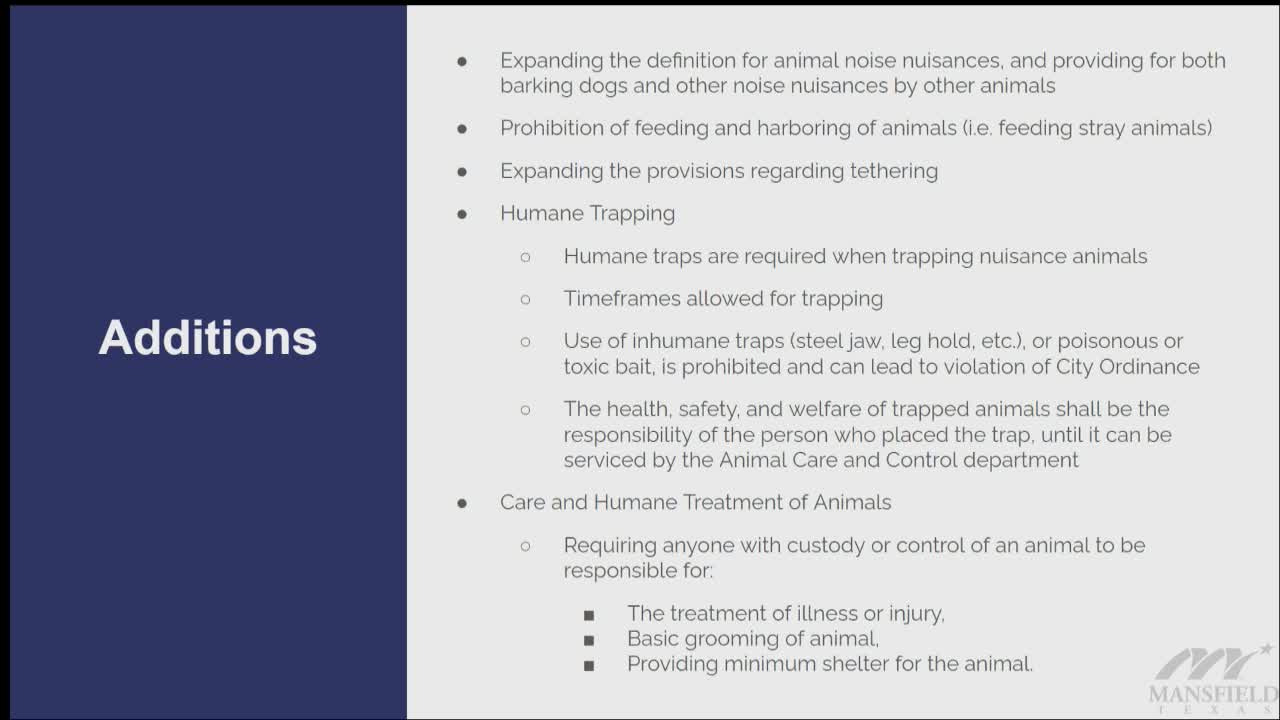City Council Approves Sweeping Reforms for Animal Welfare
October 14, 2024 | Mansfield, Tarrant County, Texas
This article was created by AI summarizing key points discussed. AI makes mistakes, so for full details and context, please refer to the video of the full meeting. Please report any errors so we can fix them. Report an error »

In a recent government meeting, significant updates to local animal control ordinances were discussed, reflecting a comprehensive overhaul aimed at enhancing animal welfare and public safety. Key changes include an expanded definition of animal noise nuisances, which now encompasses not only barking dogs but also other disruptive animal sounds. The meeting highlighted new regulations on the humane treatment of animals, emphasizing the responsibility of pet owners to provide adequate care, shelter, and medical attention.
A notable addition is the humane trapping section, which mandates the use of humane traps and outlines procedures for the animal control department to follow upon capturing animals. The ordinance also introduces stricter guidelines regarding the tethering of animals and humane transport in vehicles.
One of the more controversial topics was the new regulations surrounding the slaughtering of animals for personal consumption. Under the revised rules, individuals are permitted to slaughter animals at home, provided the process is conducted discreetly and waste is disposed of properly. However, the meat must be for personal use only and cannot be sold.
The meeting also addressed the definition and handling of dangerous animals, expanding the criteria to include dogs that attack other animals, not just humans. This change aims to provide a clearer framework for addressing incidents involving aggressive animals, ensuring that municipal courts can effectively manage such cases.
Additionally, the council discussed the implications of recent state legislation that limits local governments' ability to impose regulations on agricultural operations, including livestock and poultry keeping. The new law requires cities to demonstrate clear evidence of imminent danger before enacting any restrictions, which has led to revisions in local ordinances regarding the keeping of livestock and poultry.
The council plans to reconvene in two weeks for a follow-up work session to further discuss these changes and address any remaining questions from council members. The comprehensive nature of these updates indicates a strong commitment to improving animal welfare standards while balancing the interests of pet owners and agricultural operations.
A notable addition is the humane trapping section, which mandates the use of humane traps and outlines procedures for the animal control department to follow upon capturing animals. The ordinance also introduces stricter guidelines regarding the tethering of animals and humane transport in vehicles.
One of the more controversial topics was the new regulations surrounding the slaughtering of animals for personal consumption. Under the revised rules, individuals are permitted to slaughter animals at home, provided the process is conducted discreetly and waste is disposed of properly. However, the meat must be for personal use only and cannot be sold.
The meeting also addressed the definition and handling of dangerous animals, expanding the criteria to include dogs that attack other animals, not just humans. This change aims to provide a clearer framework for addressing incidents involving aggressive animals, ensuring that municipal courts can effectively manage such cases.
Additionally, the council discussed the implications of recent state legislation that limits local governments' ability to impose regulations on agricultural operations, including livestock and poultry keeping. The new law requires cities to demonstrate clear evidence of imminent danger before enacting any restrictions, which has led to revisions in local ordinances regarding the keeping of livestock and poultry.
The council plans to reconvene in two weeks for a follow-up work session to further discuss these changes and address any remaining questions from council members. The comprehensive nature of these updates indicates a strong commitment to improving animal welfare standards while balancing the interests of pet owners and agricultural operations.
View full meeting
This article is based on a recent meeting—watch the full video and explore the complete transcript for deeper insights into the discussion.
View full meeting
